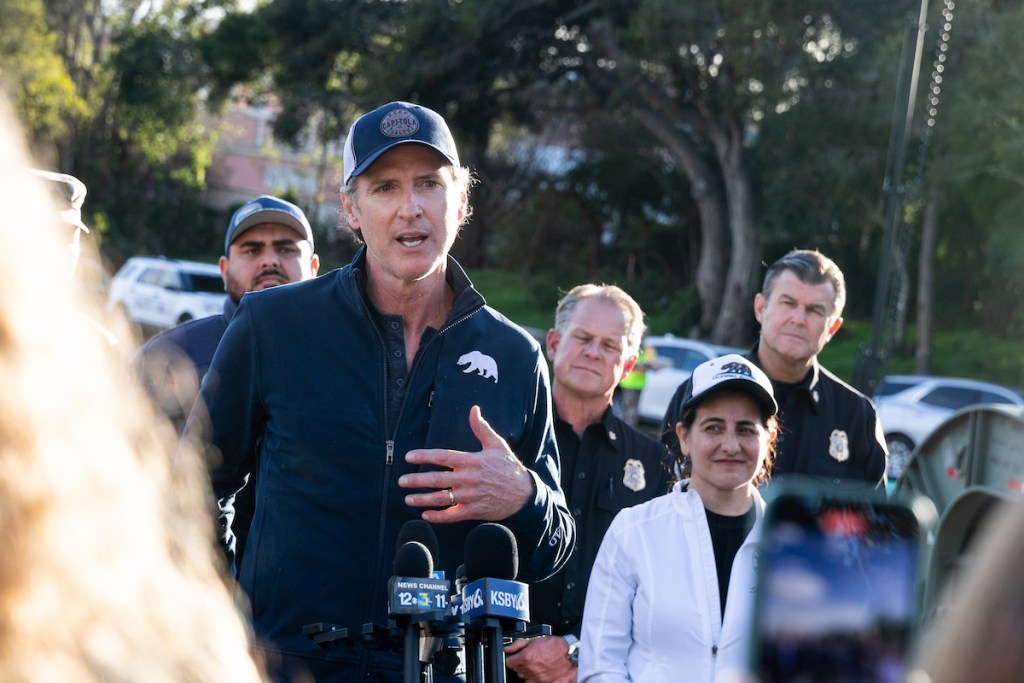The last spate of storms brought something like 50,000 cubic yards of material into Montecito’s Randall Road debris basin, which Governor Gavin Newsom visited on Friday afternoon as part of his tour around California to areas inundated by what he called the eight atmospheric rivers streaming from the Pacific over the past 20 days. His next stops were going to be to Salinas and Merced in the Central Valley, he said, and he’d come from visiting Manning Park, where he said he was impressed by the volunteers, who included some young girls competing to fill and lift sandbags.
At the basin, a division of the California National Guard were using bulldozers and a digger to lift dirt onto the berm they’d made along San Ysidro Creek, after working all night to channel it back into its bed and out of the basin. Altogether, 80 members of the National Guard will be working the basin 24 hours a day for a couple of weeks, as the weather permits. Santa Barbara County estimates that it could cost as much as $50 million to remove the rock and mud from the debris basins around the county, sort the material, and test the soil for contaminants before trucking it to the beaches.
Members of the California National Guard operate a bulldozer and digger at Randall Road debris basin in Montecito on January 13, 2023. The debris fence behind the dozer goes another 7 feet down to the floor of the basin. | Credit: Don Brubaker
In a request for an “Expedited Major Disaster Declaration” that Newsom sent to President Biden on Thursday, the governor noted that around 22 trillion gallons of water have fallen on the state since December 24, 2022, enough to cover California in 15 inches of water. The flooding was historic across the state, including in Santa Barbara, where more than 10 inches fell in 24 hours, the letter indicated, and at Los Gatos Creek in Fresno County, where the expected 6 feet actually crested at 14 feet. Flooding and broken levees caused damage in Merced, Monterey, Sacramento, San Luis Obispo, and Ventura counties, with downed trees and mudflows affecting roads in Mono, Inyo, Yolo, Kern, Los Angeles counties, and more — 41 counties in total — all of which must now be repaired.
On January 11, nearly 17,000 people were under evacuation orders statewide and another 40,000 under an evacuation warning. The letter puts Santa Barbara County’s evacuation total at nearly 10,000 people “exactly 5 years to the day following the deadly Montecito mudslide.”
The state had no time to waste, said Congressmember Salud Carbajal, as a small crowd waited on the governor’s arrival. “I called, [Senator Alex] Padilla, [Senator Dianne] Feinstein, we all called the White House, and Governor Newsom. The letter is waiting now for Biden to sign it.”
After Newsom walked in quietly, wearing a cap and taking a route behind the reporters and cameramen looking the other way, County Supervisor Das Williams welcomed him, outlining the history of Randall Road, where two people lost their lives in the debris flow that claimed 23 people in 2018. “This debris basin was finished just in time for the storm it was built for,” Williams said.
Thanking the governor for his visit, State Senator Monique Limón reminded the gathering of the storm’s reach across her district: “Though we’re here today, in North County, and across the tri counties, all have experienced damage from these storms.” The videos of the man kayaking on Santa Barbara’s lower Eastside reminded her of seeing people canoeing in the same area during the 1990s, she said. The Eastside and the Westside flooded, and also Guadalupe and Orcutt in North County, Limón said, “and this affects school children and working people across the region — and in 41 counties.”
If the Federal Emergency Management Agency approves the major disaster declaration, funds could become available to help private homeowners and businesses, as well as governments working to restore roads, bridges, harbors, and other infrastructure. Newsom’s letter stated only 5 percent of residents in most counties have flood insurance, and 30 percent lack homeowner’s or personal property insurance.
At Randall Road, the governor also reeled off the millions and billions California was spending or had budgeted for the drought and to update the water infrastructure, which he said was designed for the 20th century. Among them is the controversial Delta tunnel project, now in the environmental review stage, which could have conserved some of those trillions of gallons of water. Other possible measures were “natural” ones, Newsom commented, including infiltration and ponding at parks and in fields. And he paused to wonder at the number of times Highway 1 has had to be rebuilt.
California had allies in its quest for federal funds, and Newsom praised the elected officials who were contacting the White House on the state’s behalf. The president’s Chief of Staff Ron Klain seemed to be waiting by the telephone, Newsom said, calling him almost immediately upon receiving an earlier disaster request, and Newsom said he’d spoken to Biden a couple of days ago. A FEMA administrator arrived in California yesterday and was meeting with the state team, he said, and starting to assess the damage.

